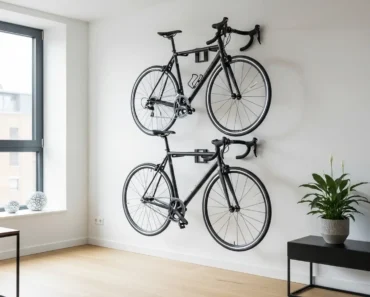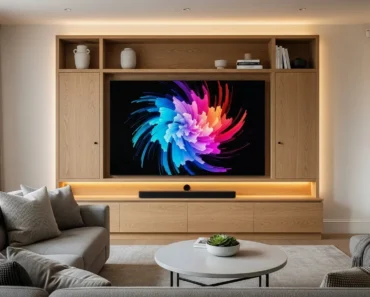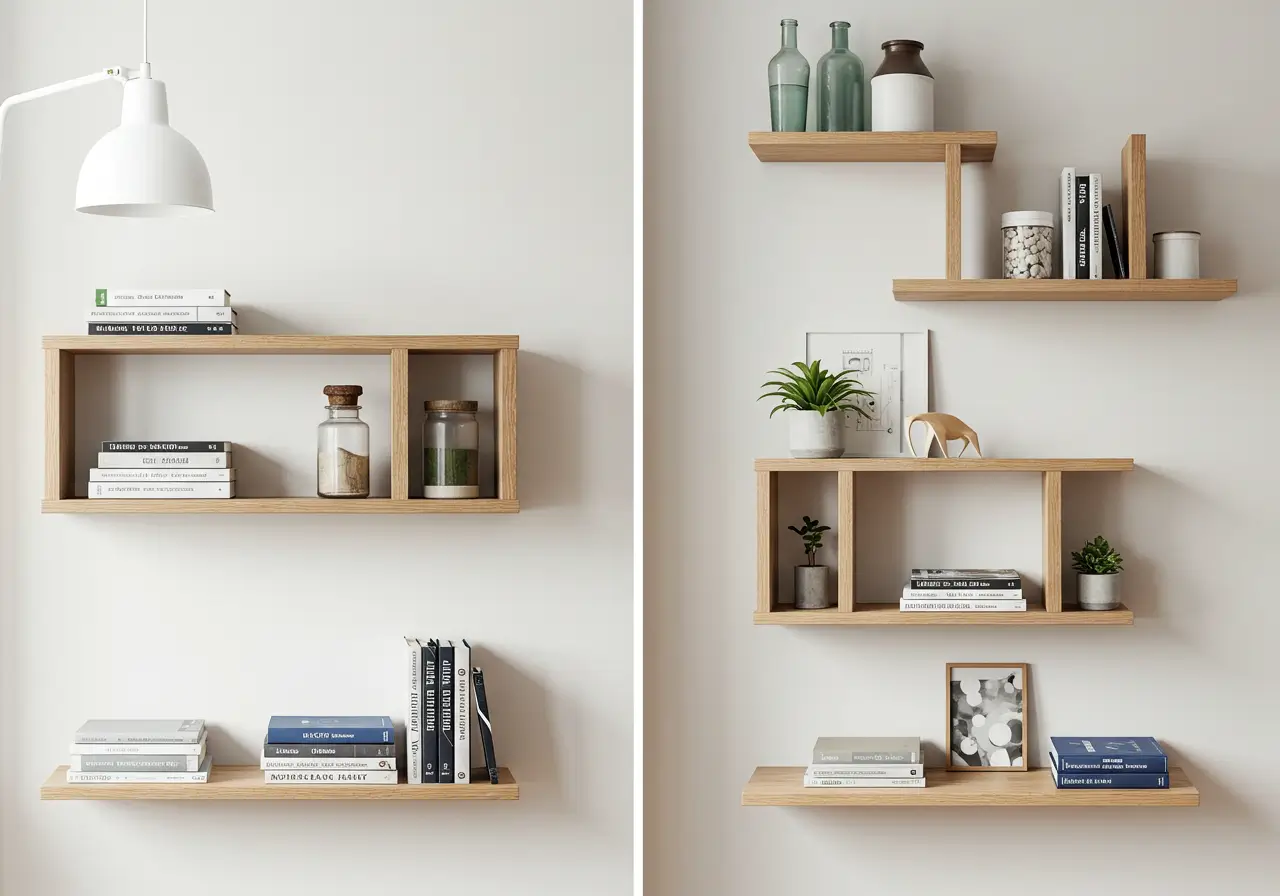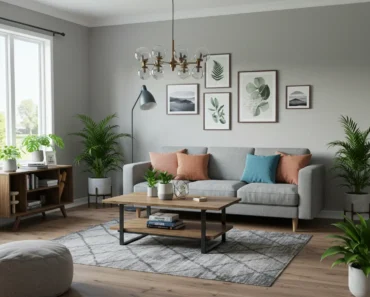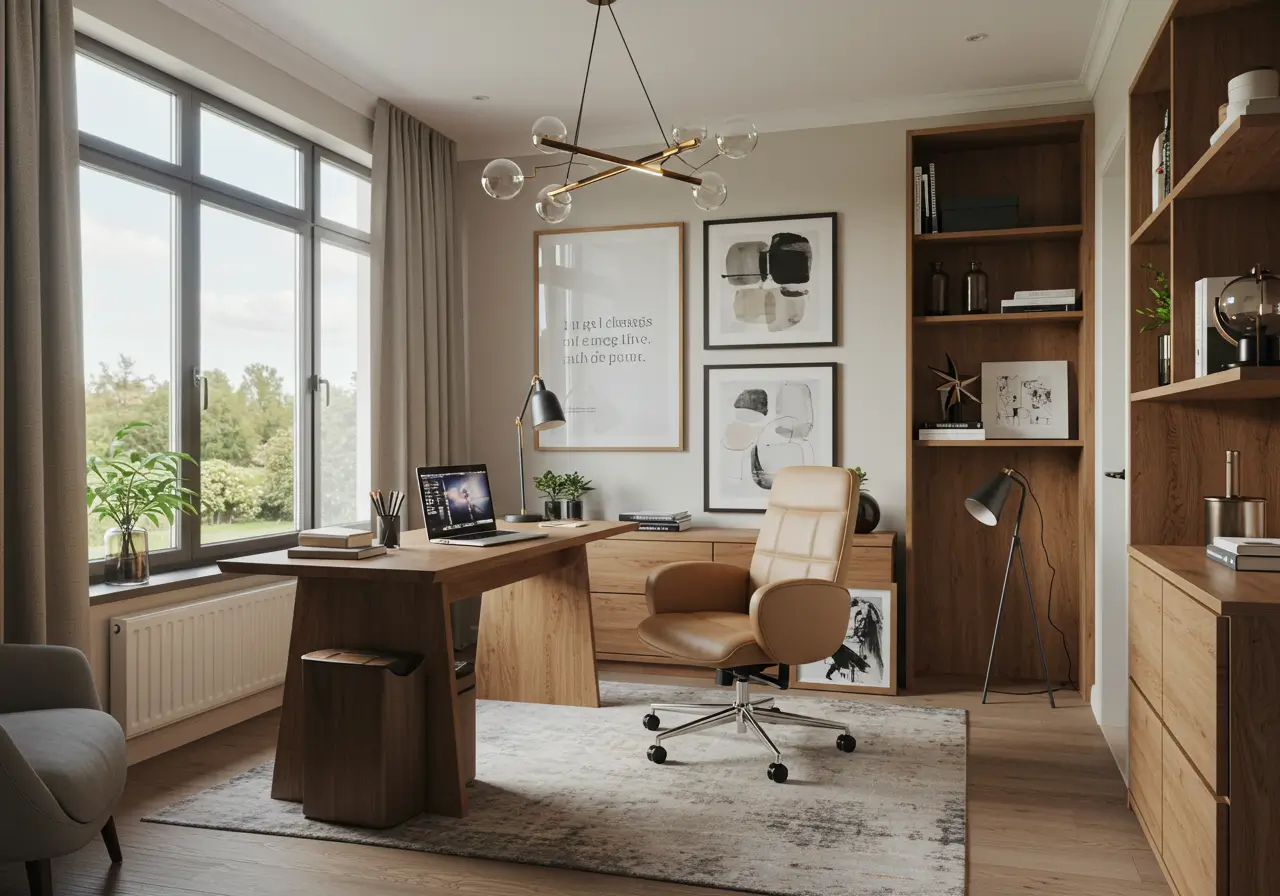A gallery wall layout guide for homeowners and renters, covering picture hanging at 57 inches, French cleat mounting, 3000K LED picture lights, UV acrylic glazing, mat board sizing, and renter-friendly wall art.
A gallery wall layout creates a stunning, personalized display for your home. Start with one piece at a 57-inch center height, use French cleat mounting for stability, and enhance with 3000K LED picture lights and UV acrylic glazing. This guide covers planning, mat board sizing, and renter-friendly wall art solutions.
Tip: Begin with one wall, mock up with paper templates, and maintain 2–3 inch gaps for a cohesive wall art arrangement.
Gallery Wall Layout vs. Statement Piece
Choose a gallery wall layout for a dynamic, layered aesthetic or a single large piece for a calm focal point.
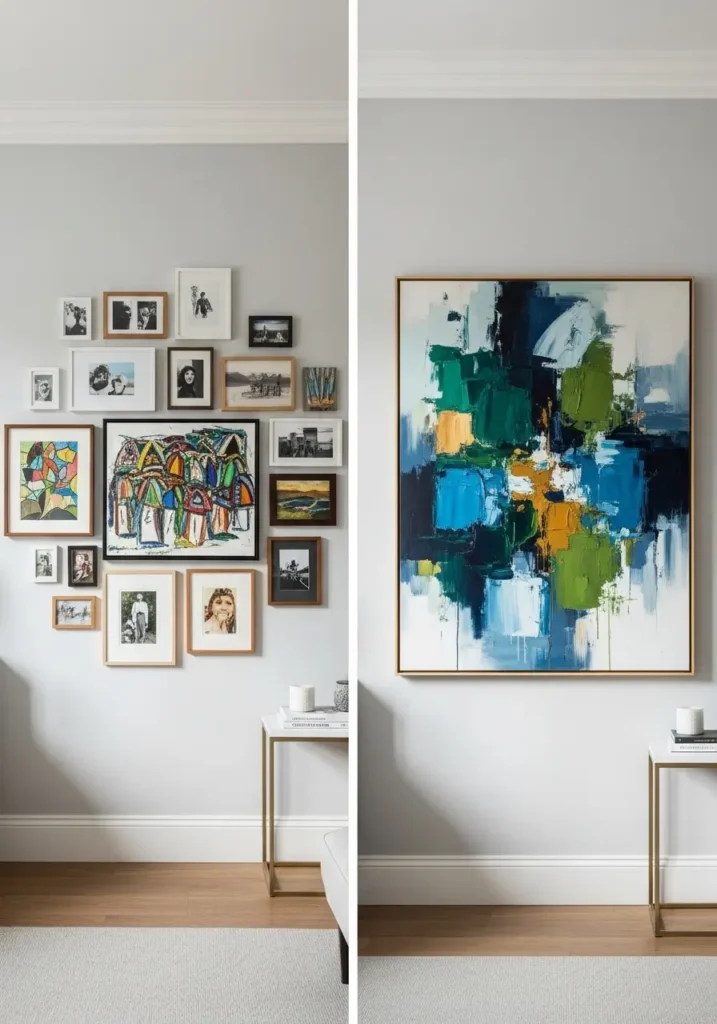
| Criterion | Gallery Wall | Statement Piece | What it means |
|---|---|---|---|
| Look | Layered, personal, flexible | Clean, bold, calm | Match the format to your room’s pace |
| Planning | More measuring and spacing | One big size decision | Time vs scale risk |
| Budget | Many small costs over time | One higher cost now | Phase a gallery or save for one piece |
| Change | Easy to swap or add | Stable focal point | Rotate often or keep steady |
| Best walls | Long or stair walls | Over sofas or mantels | Match wall shape to format |
A gallery wall layout is ideal for collectors seeking flexibility, while a statement piece anchors small spaces, making them feel larger.
Planning Your Gallery Wall Layout
Plan a gallery wall layout with paper templates for precision:
- Trace each frame on kraft paper and mark the hanging point.
- Tape templates to a 57-inch center line with 2–3 inch gaps.
- Step back from the doorway and main seat to check balance.
- Recheck center height and gaps before drilling.
Gallery Wall Layout Sightlines
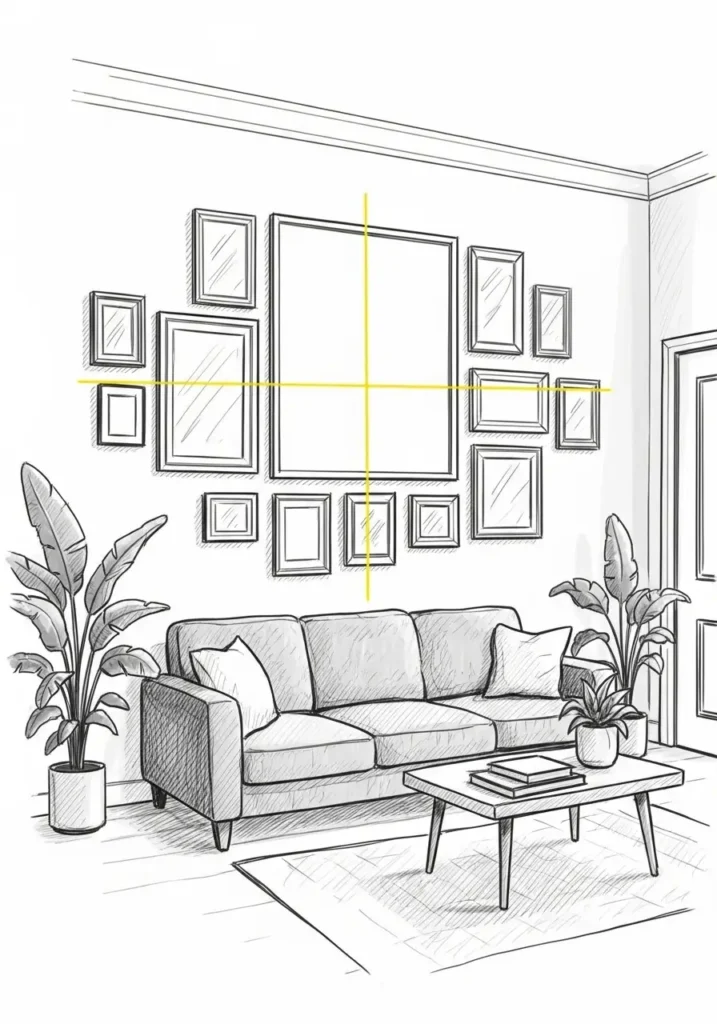
- Stand at the entry, sofa, and dining chair to note what your eyes hit first.
- Aim the largest work at the main sightline.
- Avoid vents, returns, and switch clusters.
- Confirm lamp heights won’t glare on glass.
Gallery Wall Layout Tools
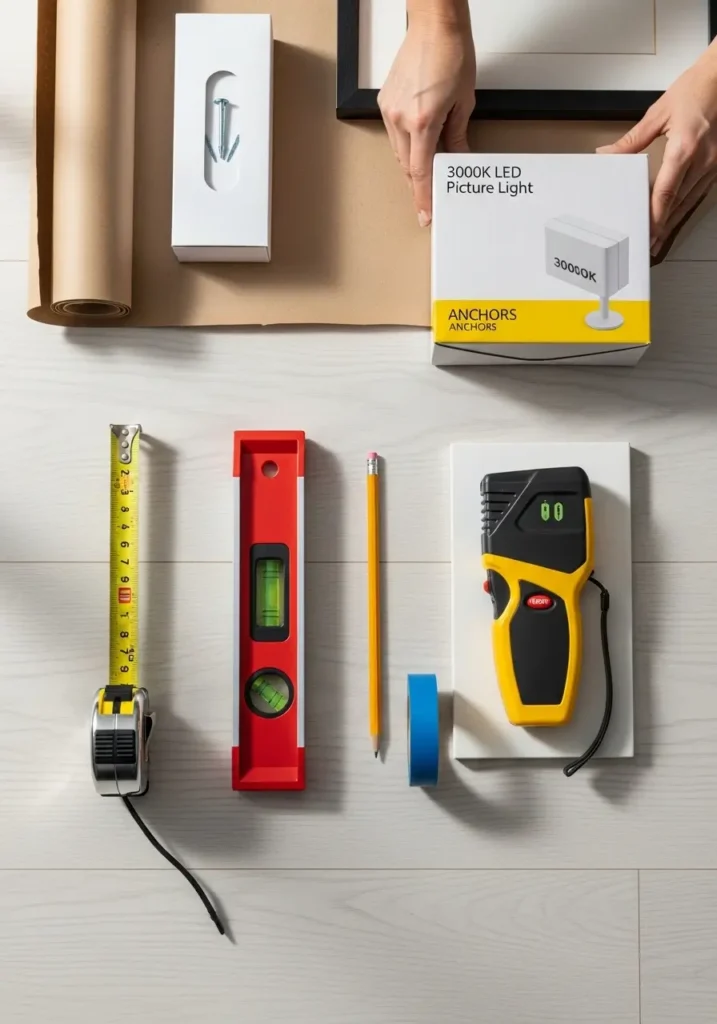
- Tools: Tape measure, level, pencil, painter’s tape, stud finder.
- Time: 60–120 minutes for one wall.
- Cost: $10–$30 for anchors and paper; $40–$150 for a 3000K LED picture light.
- Extra hands: Helpful for leveling and spacing.
Framework: Choose format → Mark 57″ center → Mock with paper → Lock 2–3″ gaps → Install anchors → Hang → Light.
Height and Scale for a Gallery Wall Layout
Picture Hanging Height
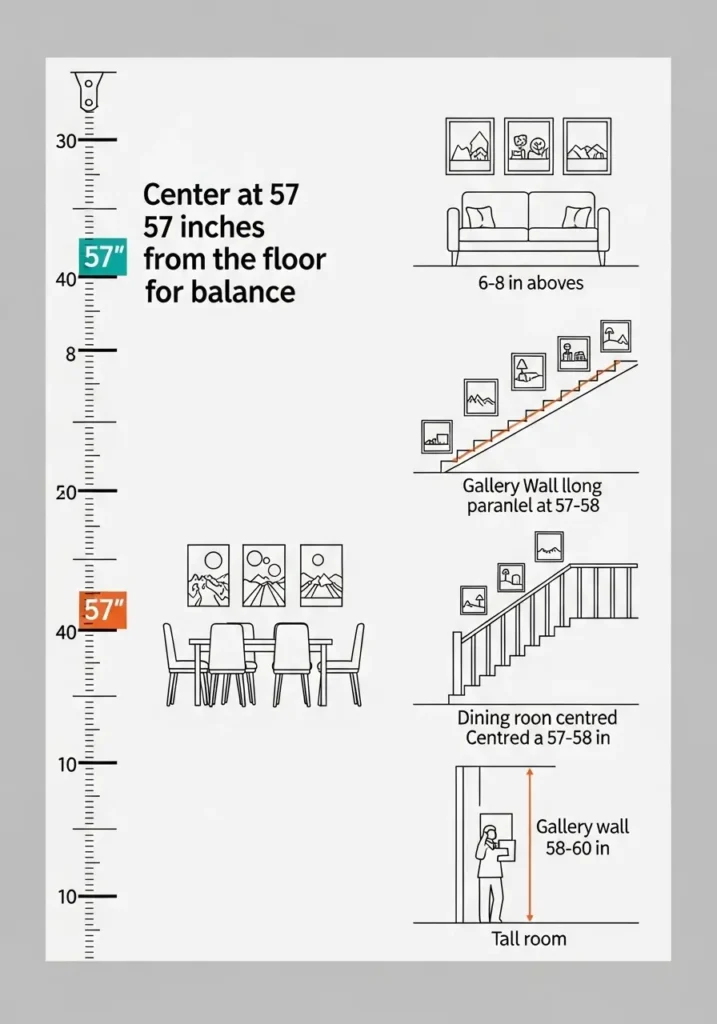
Center your gallery wall layout at 57 inches from the floor for balance:
- In tall rooms, try 58–60 inches.
- Over a sofa or console, keep the bottom edge 6–8 inches above.
- For stairs, align centers parallel to the handrail.
- In dining areas, favor 57–58 inches for seated view.
Scale and Spacing
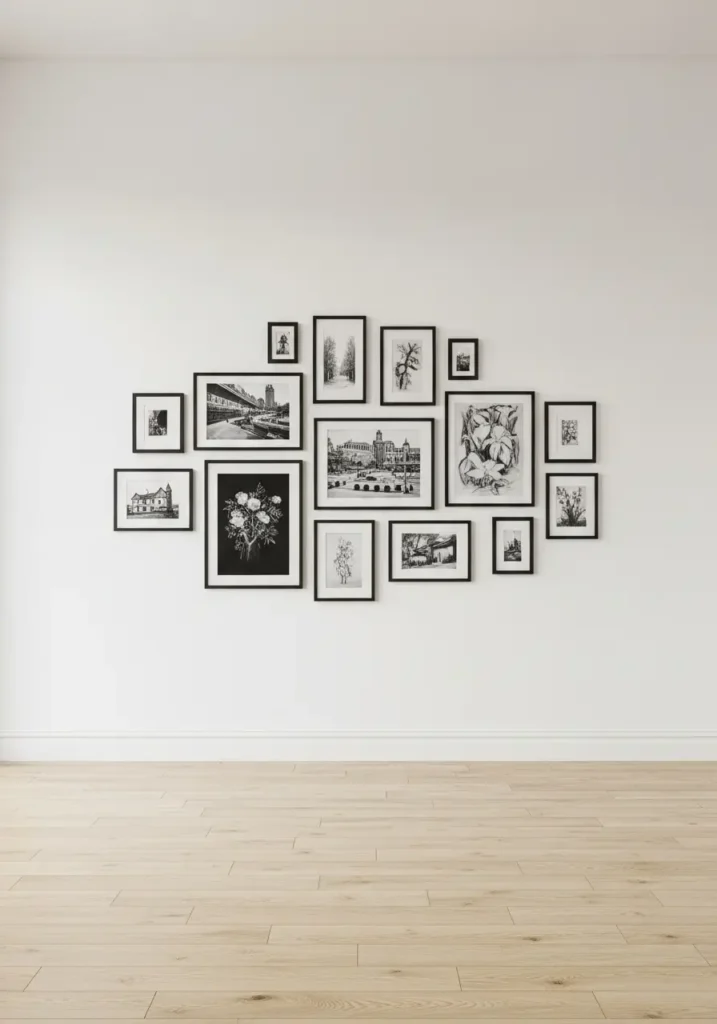
- Over sofas: About two-thirds the sofa width.
- Bare walls: Keep 4–8 inches from side edges.
- Grids: Use same-size frames.
- Salon mixes: Align around one center line.
- Spacing: Use 2–3 inch gaps; cut a wood spacer for consistency.
- Stability: Use two hooks per frame and rubber bumpers on bottom corners.
Frames and Mat Board Sizing
Frame Styles
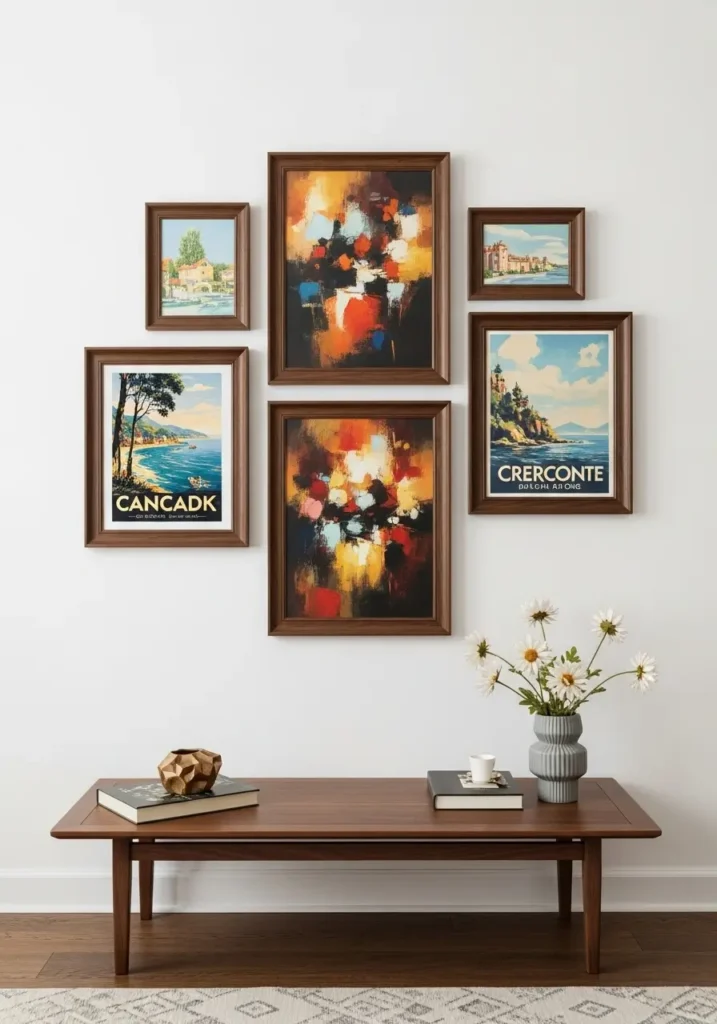
Black metal: Crisp for photos and graphic prints.
Natural oak: Soft for airy rooms.
Walnut: Warm for mid-century and classic spaces.
White: Clean for coastal or minimal looks.
Tip: Thin rails read modern; thicker rails read traditional.
Mat Board Sizing
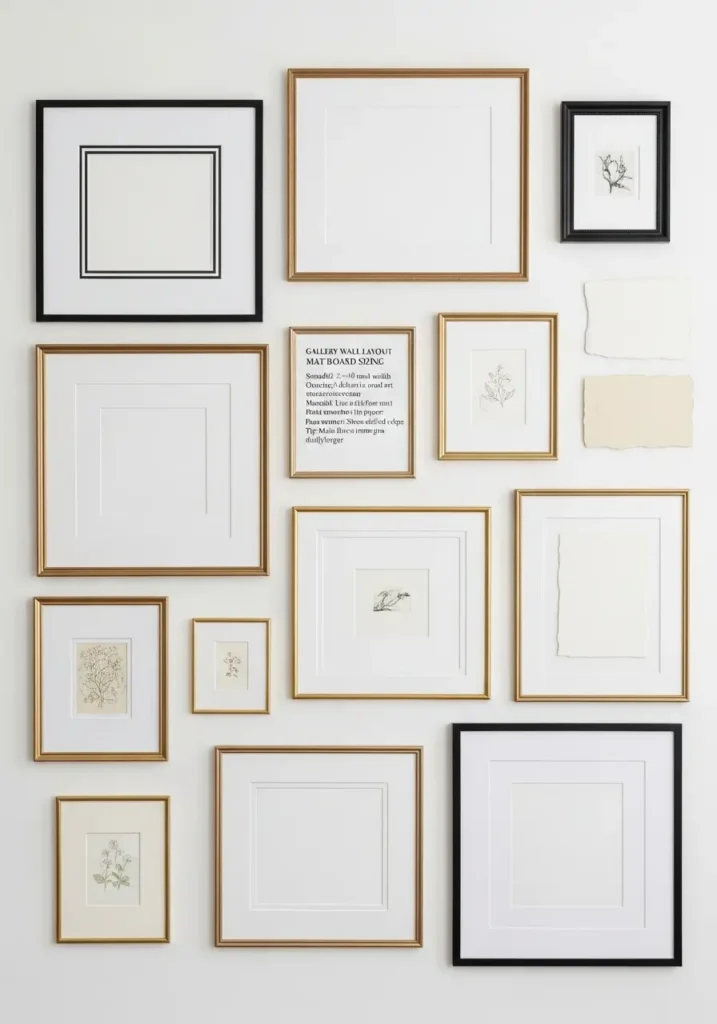
Standard: 2–3 inch mat width.
Oversize: Adds drama to small art.
Material: Use acid-free mat and backing for paper.
Float mount: Shows deckled edges.
Tip: Make the bottom margin slightly larger.
UV Acrylic Glazing
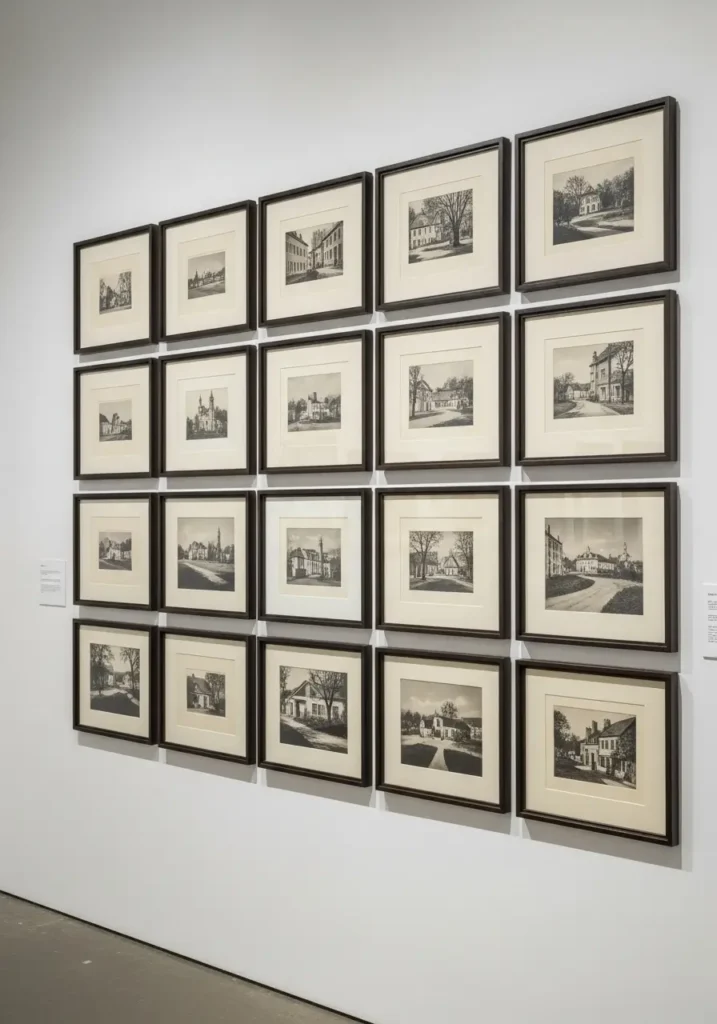
UV-filter acrylic: Light, safe for kids’ rooms.
Non-glare: Cuts reflections, softens detail.
Standard glass: Fine for shaded walls.
Cleaning: Use dry microfiber; avoid ammonia near art.
Related Post: How Your Small Backyard Deck Could Feel This Peaceful
French Cleat Mounting and Hardware
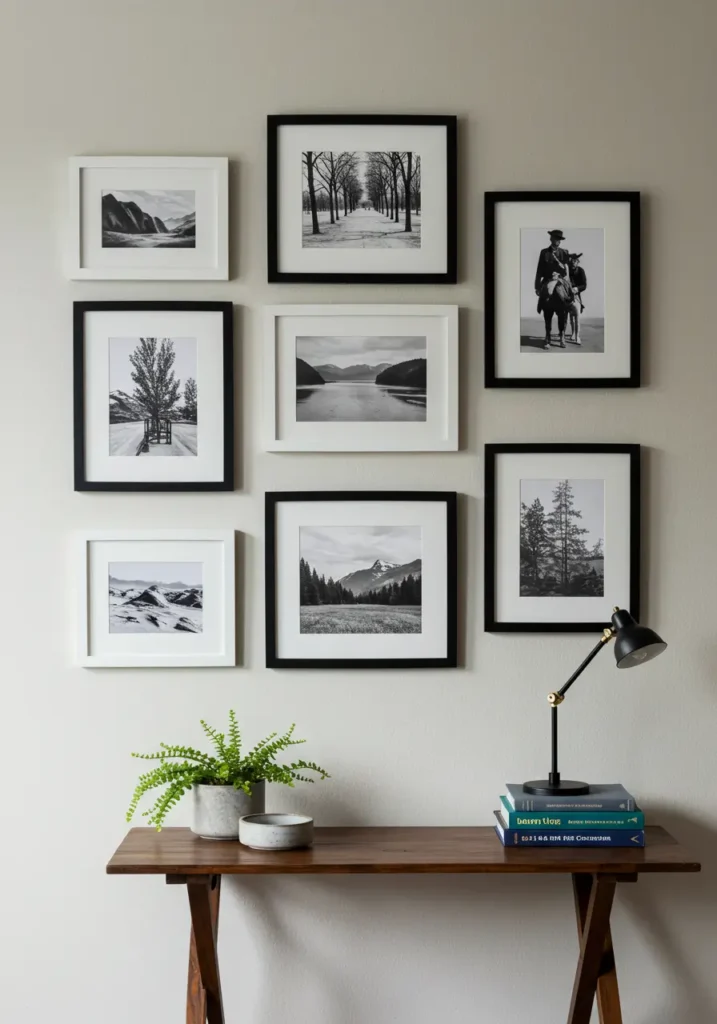
Select hardware for your gallery wall layout based on wall type and art weight:
- Studs: Wood screws with D-rings.
- Drywall: Weight-rated anchors.
- Heavy or wide: French cleat for secure mounting.
- Brick: Masonry anchors with pilot holes.
- Renters: Removable strips within weight limits.
- Safety: Use two hooks per frame, short wire, and rubber bumpers. In quake zones, add security clips.
Log each frame’s weight and hardware for future reference.
3000K LED Picture Lights for Gallery Wall Layout
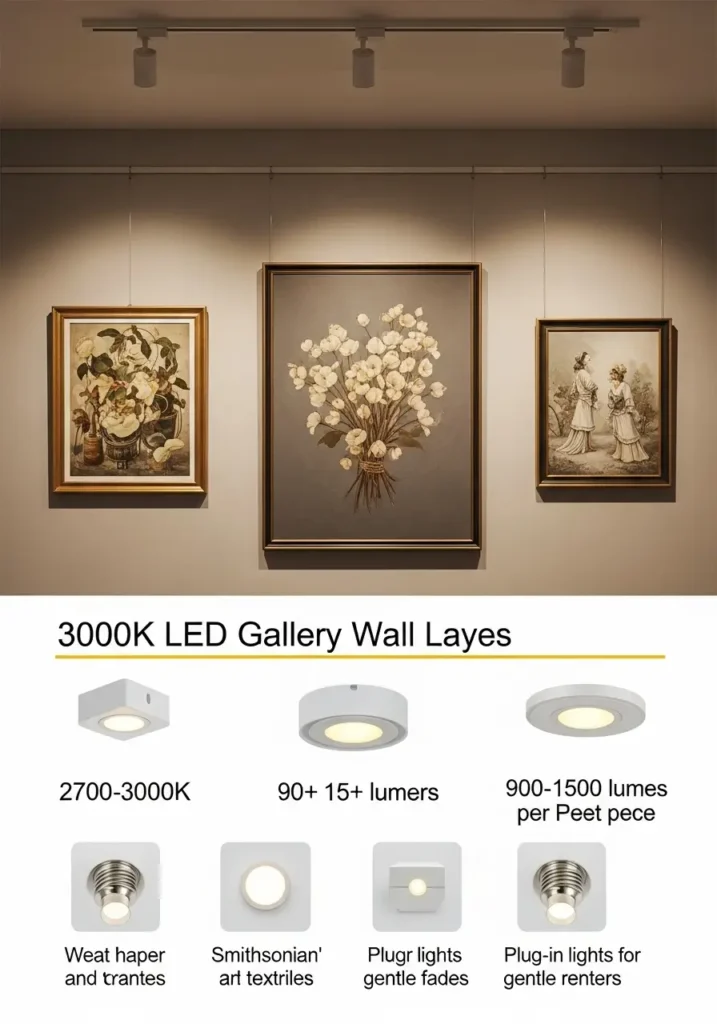
Illuminate your gallery wall layout with 3000K LED picture lights to protect art and enhance visuals. Heat and UV can fade paper and textiles; see the Smithsonian’s light and art care guidance.
- Color temperature: 2700–3000K for warm whites.
- CRI: 90+ for true colors.
- Output: 900–1500 lumens per piece.
- Fixtures: Picture lights, track heads, recessed accents, or plug-in lights for renters.
- Control: Add dimmers; smart bulbs for gentle fades.
For bulb selection, see Energy.gov’s LED lighting basics.
Renter-Friendly Gallery Wall Layout
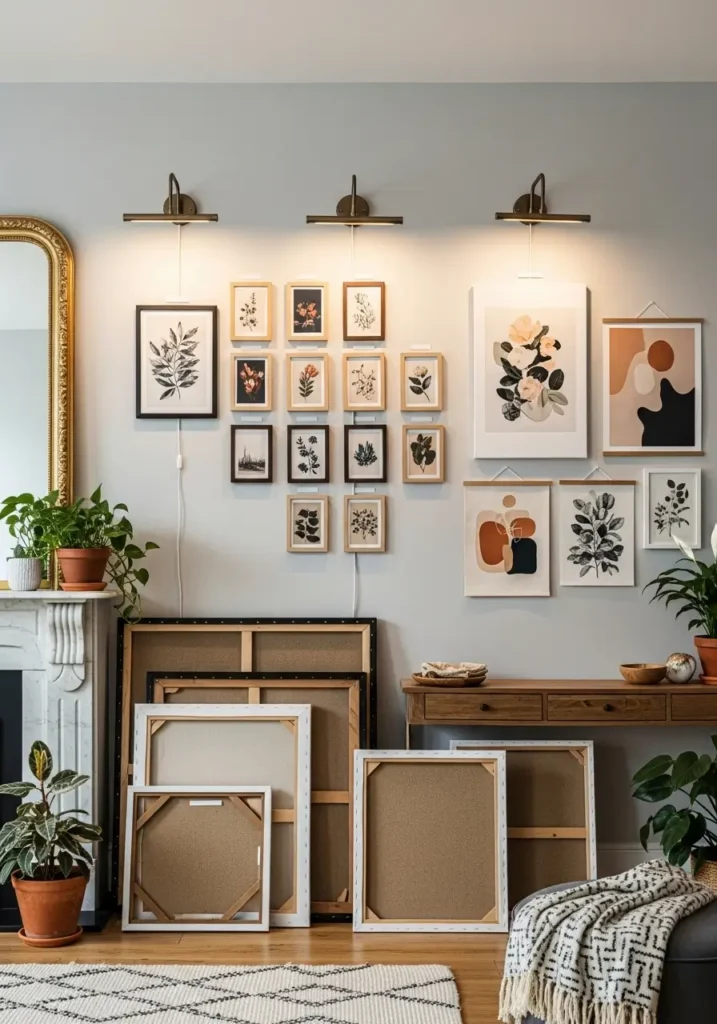
Design a renter-friendly gallery wall layout without permanent damage:
- Lean larger frames on consoles or mantels.
- Use removable strips within weight limits.
- Build a tight grid with small frames.
- Pick canvas or fabric posters without glass.
- Use plug-in 3000K LED picture lights, not hardwired.
Real-World Gallery Wall Layout Anecdote
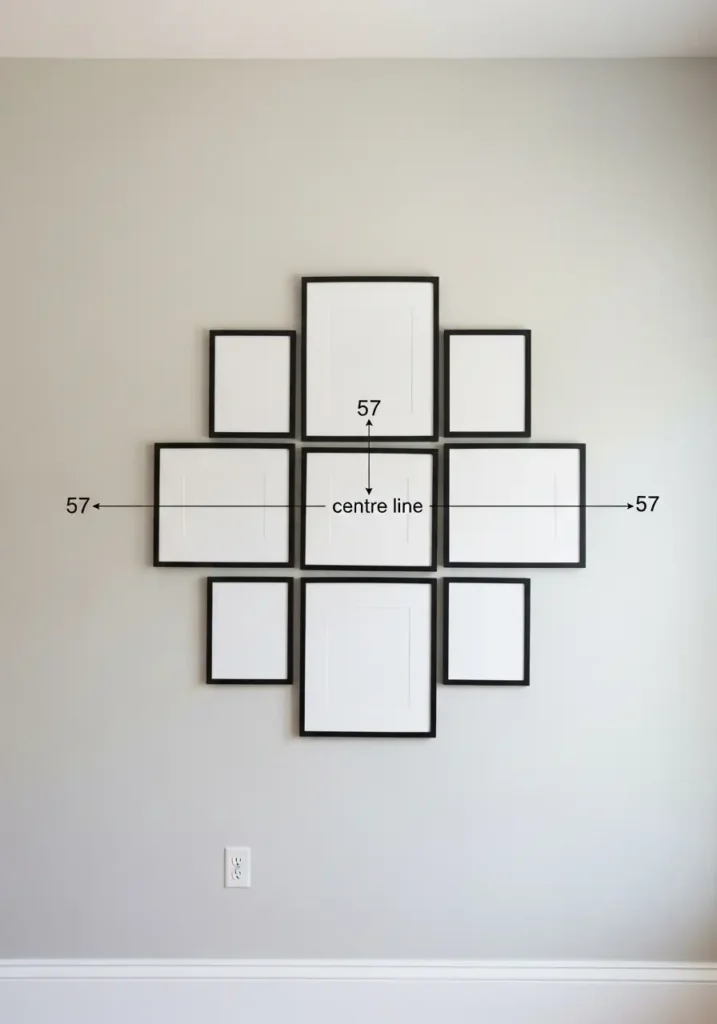
I installed a nine-piece gallery wall layout in a 1920s bungalow with wavy plaster. The trim looked straight, but the ceiling line drifted. I mapped a 57-inch center across the wall and aligned the group to that line, not the trim. Using two hooks per frame, French cleats for heavier pieces, and bumpers, the layout still reads level years later. Trust the center line and a fixed spacer block.
Quick Fixes for Gallery Wall Layout Issues
Crooked Frames
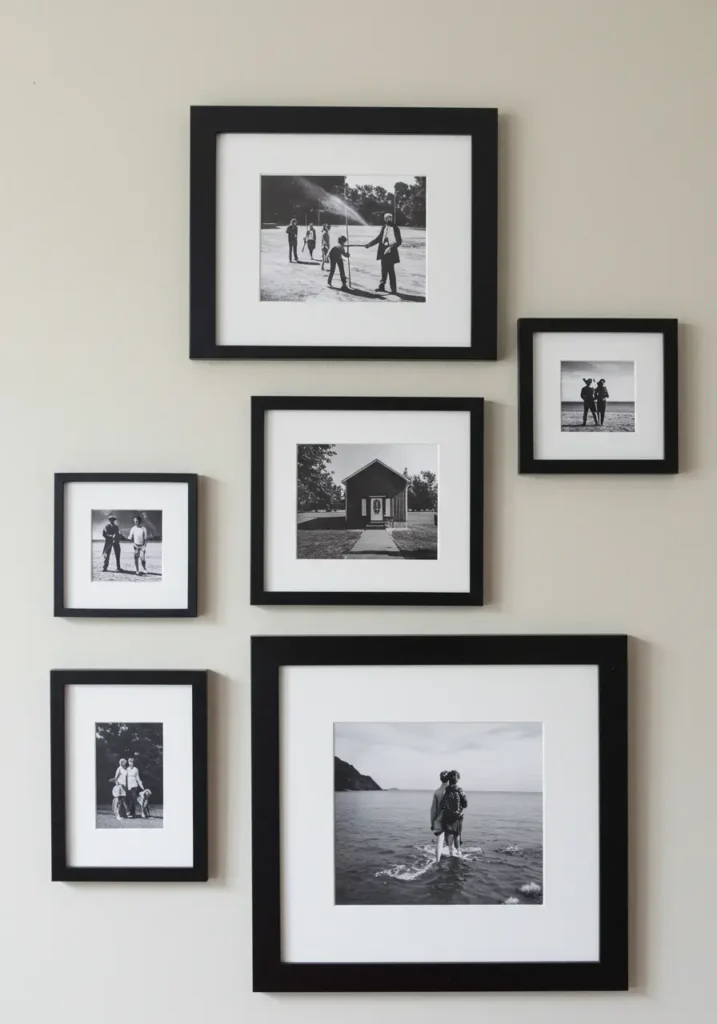
- Use two hooks instead of one.
- Add clear bumpers to bottom corners.
- Shorten the wire to reduce swing.
- Level at the top rail.
- Dust the back so bumpers grip.
Weak Anchors or Damaged Drywall
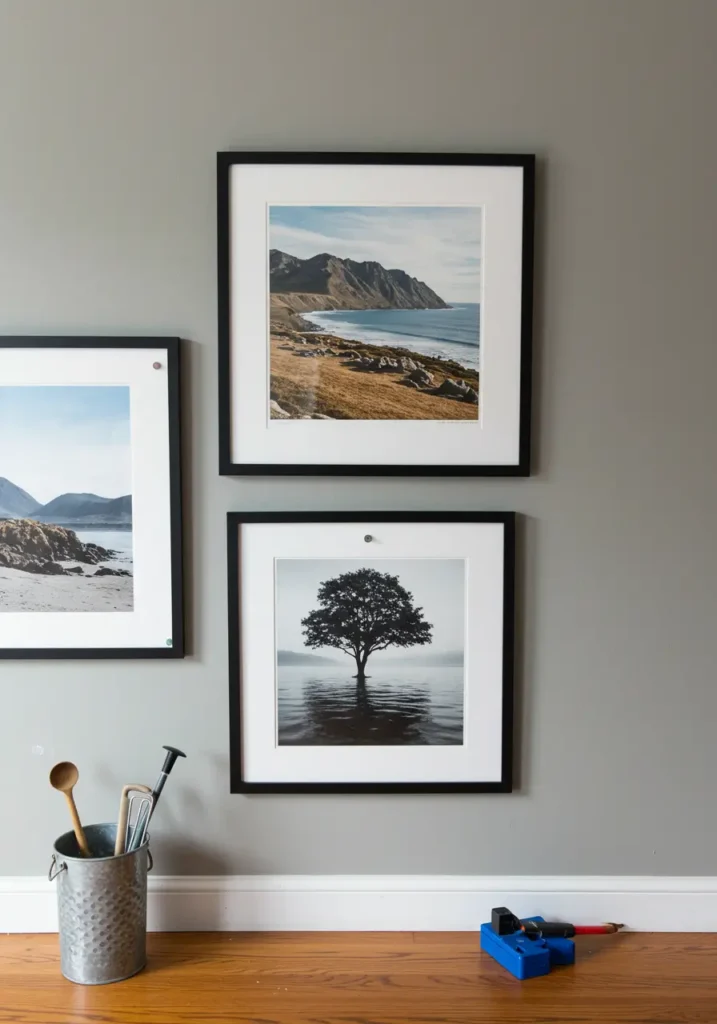
- Match anchor to wall thickness and weight.
- Move 1–2 inches and patch later.
- Use a French cleat for heavy or wide pieces.
- Find studs near corners and outlets.
- Log the anchor type on the frame back.
Busy or Off-Center Layout
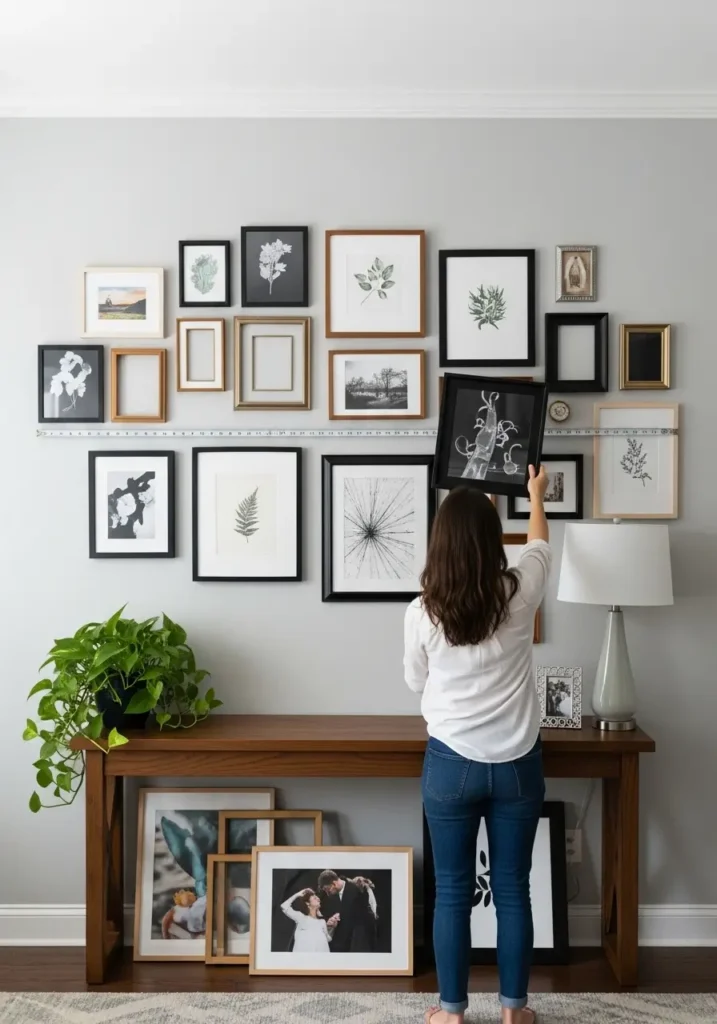
- Reset to a 57-inch center line.
- Standardize gaps to 2–3 inches.
- Match frame color or rail thickness.
- Remove the weakest piece and rebalance.
- Align the group to the furniture center.
Safety: In quake-prone regions, add security hooks or clear clips over the frame lip. Avoid heavy pieces above beds or cribs.
FAQs on Gallery Wall Layout
What height should I use for a gallery wall layout?
Use 57 inches to the center for most rooms. In tall spaces, 58–60 inches can feel right. Over furniture, keep the bottom edge 6–8 inches above the surface.
How wide should art be over my sofa?
Pick a width near two-thirds of the sofa. This ties the art to the seating and reduces empty space at the ends.
How do I reduce glare in a gallery wall layout?
Use matte UV acrylic glazing and aim 3000K LED picture lights at a 30° angle. Test from the seat you use most and adjust until reflections fade.
What anchors work best in drywall?
Use weight-rated anchors that match the load. For heavy or wide pieces, mount with a French cleat into at least one stud.
Is a gallery wall layout hard to keep straight?
No. Lock gaps at 2–3 inches, use two hooks per frame, and mock up with paper first. A spacer block keeps gaps even.
